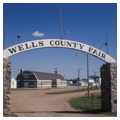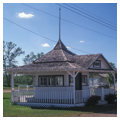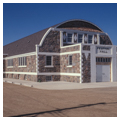Beginning in the late nineteenth century, agricultural associations were established by locally prominent businessmen interested in “booming” their areas. Between 1889 and 1912, one hundred and forty such organizations were incorporated in North Dakota. Horse racing was a primary recreational aspect of the associations. The Wells County Fair Association was incorporated in 1906 for the purpose of promoting and encouraging agriculture, horticulture, mechanics, tool making, stock raising, and domestic industry. Within six months of its organization, the association purchased a twenty-five-acre parcel at the south edge of Fessenden. Three months later, the first Wells County Fair was held and Fessenden became one of the horse racing circuit’s nine sites for 1907. Horse racing has remained an important element of the fair, reflected in the racetrack, the original grandstand, and a historic barn relocated from its original location to the southeast corner of the fairgrounds. In 1908, a large exhibit building was completed. A gateway ticket kiosk is one of the most architecturally engaging features of the site.
In 1926, a new grandstand was added to the fairgrounds, more than doubling the seating capacity for horse races and other events. A Boys and Girls Club building was constructed in 1929 to house the 4-H Club and agricultural exhibits, and to provide dining and sleeping quarters in the second story for the Junior Club members who held their annual convention during the fair. In 1935, a number of Federal Emergency Relief Administration (FERA) projects improved the fairgrounds, the most impressive of which was Festival Hall, a large building constructed of cut-granite fieldstone with an arched roof. Designed by the fair manager, Festival Hall is one of only two Wells County auditorium buildings constructed by the WPA.














